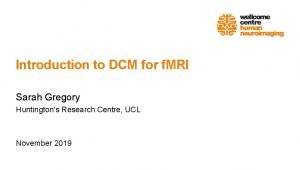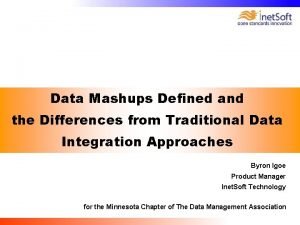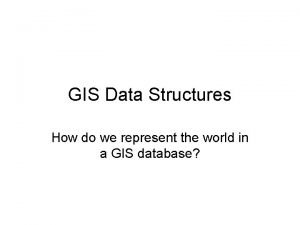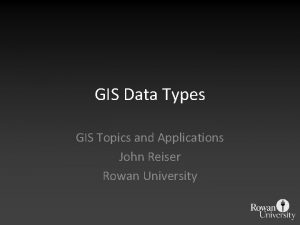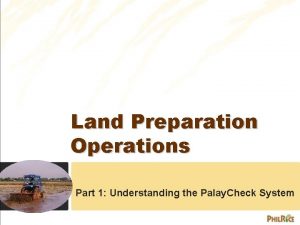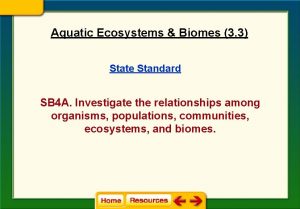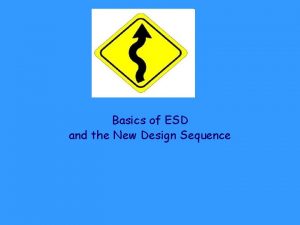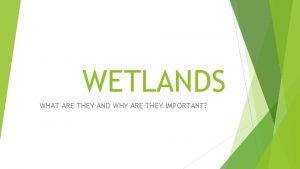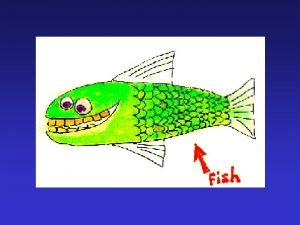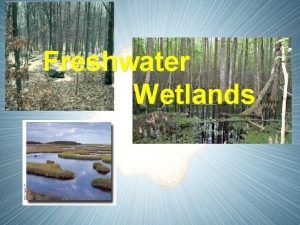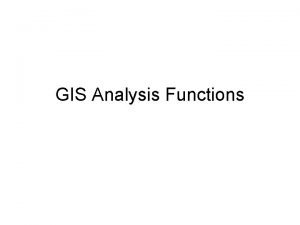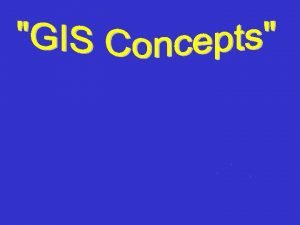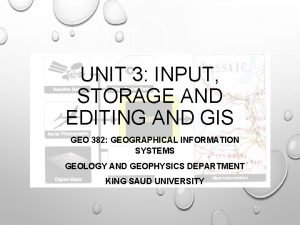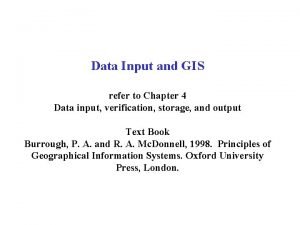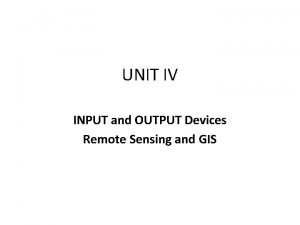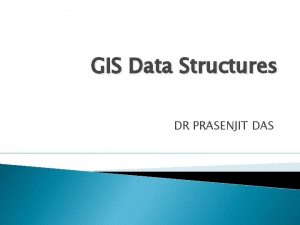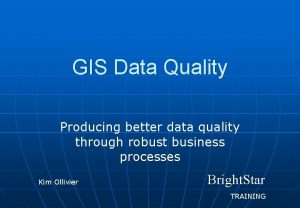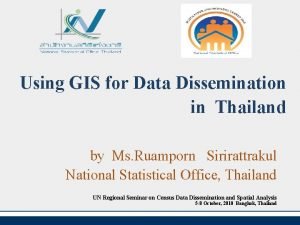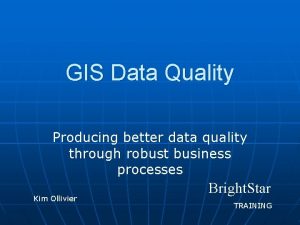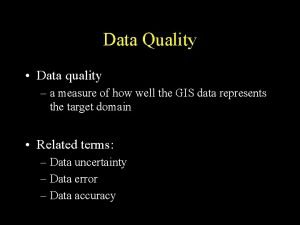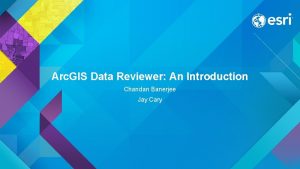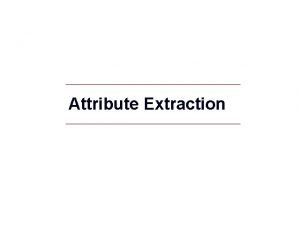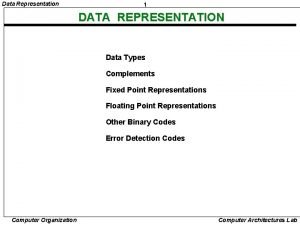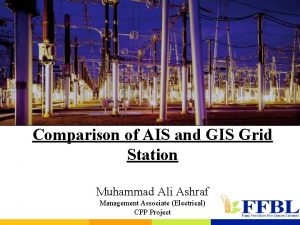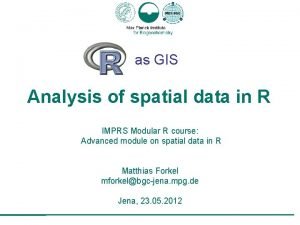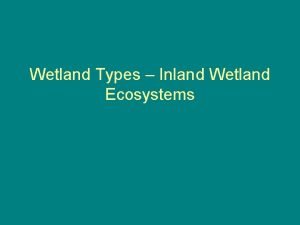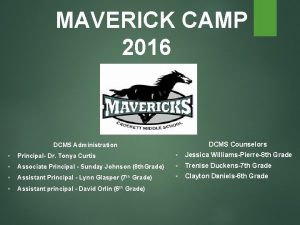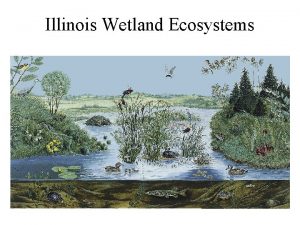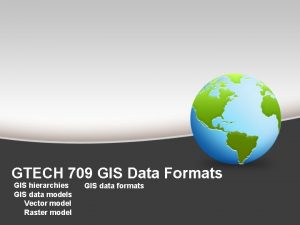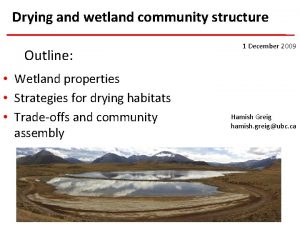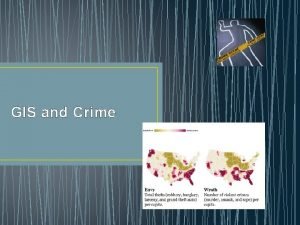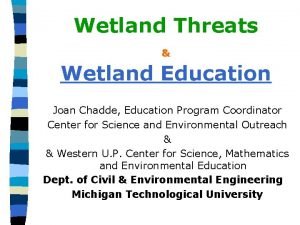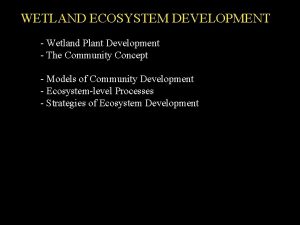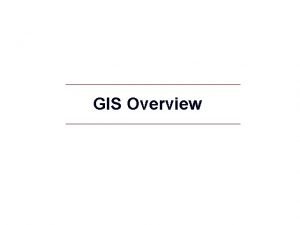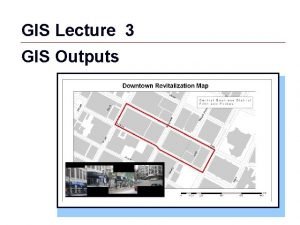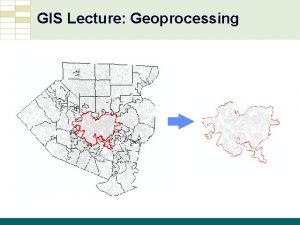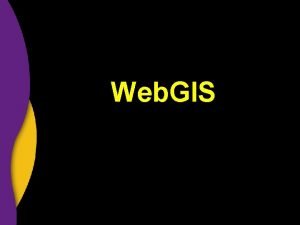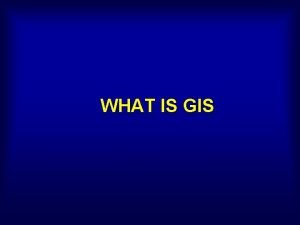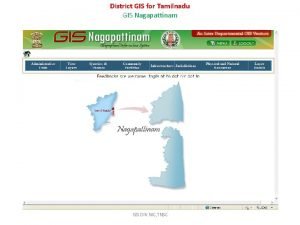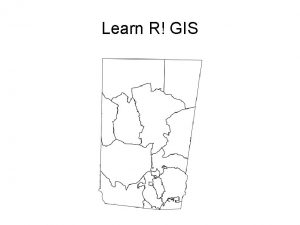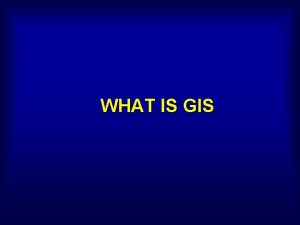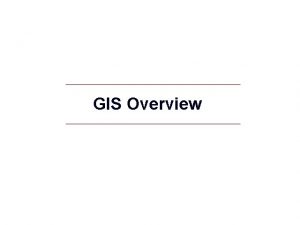Wetland Types Functions and DCMs GIS Wetland Data







































- Slides: 39

Wetland Types, Functions, and DCM’s GIS Wetland Data North Carolina Department of Environment and Natural Resources Division of Coastal Management January 2002

DCM GIS Wetland Data: • Wetland Type Data • Wetland Functional Significance Data • Potential Wetland Restoration and Enhancement Site Data • Wetland Restoration Site Functional Significance Data (in progress) January 2002

Topics • Wetland Functions • Wetland Types • GIS Wetland Data • NC-CREWS Data • Getting DCM’s Data January 2002

Wetlands are areas that are periodically or permanently inundated by surface or ground water and support vegetation adapted for life in saturated soil. Wetlands include swamps, marshes, bogs and similar areas. January 2002

What do wetlands do? Wetland Functions Habitat nesting, spawning, rearing and resting sites for aquatic and land species, food chain production Hydrology protection of other areas from wave action and erosion, storage areas for storm water and flood water, ground and surface water aquifer recharge Water Quality water quality protection, water filtration and purification, treatment of nonpoint source runoff January 2002

Why are wetlands important? Wetland Values • maintain biodiversity • reduce flood damage • provide habitat for animals • hiking, fishing, hunting, bird watching, boating • maintain water quality • support commercial fishing, forestry • aesthetic value Did you know? Nationwide, an estimated 50 million people spend approximately $10 billion annually observing and photographing wetland-dependent birds. January 2002

There are many different kinds of wetlands. People place different values on them based on the functions they perform. January 2002

Where are wetlands located? • Wetlands are located throughout NC • There are two kinds of maps in NC that show the locations and types of wetlands: 1. National Wetland Inventory (NWI) Maps 2. DCM Wetland Type Maps January 2002

Example of National Wetland Inventory (NWI) Map January 2002 NWI maps show many different wetland types

P F O 4 What? The U. S. Fish & Wildlife Service’s National Wetland Inventory (NWI) uses what is called the Cowardin Classification to classify wetlands. This classification system is used by scientists and resource managers nationwide. This complex system can be difficult for the average user to interpret. January 2002

DCM’s wetland maps are easy to understand because wetlands are grouped into well -known categories. January 2002

January 2002 Example: DCM Wetland Type Map DCM’s maps show 13 wetland types

DCM’s GIS Wetland Type Data Show the location, type, and amount of wetlands in the North Carolina Coastal Plain January 2002

DCM’s GIS Wetland Type Data uses these primary GIS layers • National Wetland Inventory (NWI) Maps • NRCS Digital Soils Maps • Satellite Imagery - 1988, 1994 • Hydrography January 2002

January 2002

DCM Wetland Classification DCM Wetland Types: • Swamp Forest • Bottomland Hardwood • Pocosin • Pine Flat • Hardwood Flat • Managed Pine • Freshwater Marsh • Salt/Brackish Marsh • Estuarine Scrub Shrub • Estuarine Forest • Maritime Forest • Headwater Swamp • Human Impacted Modifiers: l Partially Drained/ Ditched l Cut-over l Cleared January 2002

DCM Wetland Classification Hydrogeomorphic Classification (HGM): This classification describes the hydrology and the geomorphic setting of a wetland • Riverine • Flat or non-riverine • Tidal January 2002

The following slides show photos of wetland types typically found in Coastal North Carolina. January 2002

Riverine Swamp Forest January 2002

Headwater Swamp January 2002

Swamp Forest January 2002

Pocosin Wetland January 2002

Wet Pine Flat January 2002 Hard Wood Flat

Tidal Salt Marsh January 2002

Are DCM’s GIS Wetland Maps Accurate? January 2002

Accuracy Assessment • Over 600 field sites visited • Accuracy was calculated to be 89% for wetlands and 71% for uplands. That means most of the sites we map as wetlands are indeed wetlands. Most of the sites we map as uplands are non-wetlands. January 2002

Maps are the starting point DCM’s wetland maps show the location and types of wetlands What is the ecological significance of these wetlands? How important are they? January 2002

North Carolina Coastal Region Evaluation of Wetland Significance (NC-CREWS) A model that rates the functional significance of wetlands January 2002

NC-CREWS Ratings DCM staff developed a model that produces ratings for each wetland polygon in our GIS: – Beneficial Functional Significance – Substantial Functional Significance – Exceptional Functional Significance Wetlands can be evaluated on the basis of an overall rating or in terms of individual functions. January 2002

NC-CREWS Primary Wetland Functions and Subfunctions Water Quality Wildlife Habitat – Nonpoint Source Removal – Floodwater Cleansing Hydrology – Terrestrial Wildlife – Aquatic Life Potential Risk – Surface Runoff Storage – Floodwater Storage – Shoreline Stabilization January 2002 – Wetland Extent and Rarity – Replacement Difficulty – Land Use Characteristics

Example: Water Quality Function January 2002

Example: DCM GIS Wetland Type Map DCM wetland maps show wetland location and type. January 2002

Example: NC-CREWS Map NC-CREWS rates a wetland’s ecological functional significance January 2002

January 2002

Web-Based Viewing at http: //dcm 2. enr. state. nc. us/ • Click on Wetlands Data • Scroll down and click on Go to the Wetlands Data This application will allow you to view DCM’s wetland data online. You can begin by clicking or selecting a county or town. The wetland data will draw when you have zoomed in far enough. The map also includes major roads and water for reference. The following slides show an example of our online data. January 2002

January 2002

January 2002

January 2002

How to get DCM GIS Wetland Data: • From DCM on a CD as Arc/Info Export or Shapefile Wetland type, NC-CREWS, Restoration/Enhancement type data • From CGIA- Wetland type and Restoration/Enhancement type data • Transfer via FTP site • Wetland Type data is in CGIA’s Basin. Pro January 2002
 Creative industries economic estimates
Creative industries economic estimates Dcms
Dcms Dcms
Dcms Dcms
Dcms Data mashups and gis are data integration technologies.
Data mashups and gis are data integration technologies. Data mashups and gis are data integration technologies.
Data mashups and gis are data integration technologies. What is data structure in gis
What is data structure in gis Gis data types
Gis data types Use in wet and dry land preparation
Use in wet and dry land preparation Wetland dominated by nonwoody plants
Wetland dominated by nonwoody plants Submerged gravel wetland
Submerged gravel wetland Why are wetlands important for biodiversity
Why are wetlands important for biodiversity 2013 apes frq
2013 apes frq Freshwater wetlands purify water by
Freshwater wetlands purify water by Gis analysis functions
Gis analysis functions Gis analysis functions
Gis analysis functions Big data gis
Big data gis Components of gis
Components of gis Data input in gis
Data input in gis Data collection and input in gis
Data collection and input in gis Ooa
Ooa Data input devices in a gis is
Data input devices in a gis is Gis data structure
Gis data structure Data quality in gis
Data quality in gis Gis data validation
Gis data validation Thailand gis data
Thailand gis data Data quality in gis
Data quality in gis Micro and macro components of accuracy in gis
Micro and macro components of accuracy in gis Gis data validation
Gis data validation Faceb oo
Faceb oo Attribute data query in gis
Attribute data query in gis Evaluating functions
Evaluating functions Evaluating functions and operations on functions
Evaluating functions and operations on functions Complex data types in data mining
Complex data types in data mining Types of data representation in computer
Types of data representation in computer Eck
Eck Complex data types in data mining
Complex data types in data mining Ais grid station
Ais grid station Future trends
Future trends R for gis
R for gis



